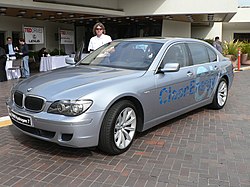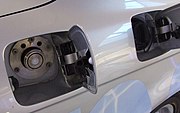BMW Hydrogen 7
 | |
| Manufacturer | BMW |
|---|---|
| Class | Executive car |
| Related | BMW 7 Series |
The BMW Hydrogen 7 is a limited production hydrogen vehicle built by German automobile manufacturer BMW. The car is based on BMW’s traditional gasoline powered 7-series line of vehicles, and more specifically the 760Li. It uses the same 6 litre V-12 motor as does the 760i and 760Li; however, it has been modified to also allow for the combustion of hydrogen as well as gasoline, making it a bivalent engine. Unlike many other current hydrogen powered vehicles like those being produced by Honda, General Motors, and Daimler Chrysler - which use fuel cell technology and hydrogen to create electricity to power the vehicle - the BMW directly ignites the hydrogen in its internal combustion engine.
Production
BMW claims the Hydrogen 7 is the “world’s first production-ready hydrogen vehicle”; thus far, the Hydrogen 7 has only been released to select high-profile lessees. Only 100 total vehicles have been produced to put their technology to the test, and no more are planned to be produced. BMW says it chose public figures such as politicians, media figures, businessmen and big names in the entertainment industry such as 2007 Academy Award-winning director Florian Henckel von Donnersmarck and the chairman of Sixt AG, Erich Sixt, because “they would be ideal ambassadors” for hydrogen fuel and can help spread awareness of the need for such technologies.
There is doubt, however, over whether or not this automobile will ever be put into larger production, even if hydrogen fuel technology reaches the point of economical and “green” feasibility, as well as to have the infrastructure required to put hydrogen vehicles in demand. The Hydrogen 7 uses more fuel than many trucks, consuming 13.9 L/100km for gasoline (petrol) and 50 L/100km for hydrogen. The following table shows the consumption (L/100km) and fuel economy (mpg) for both Imperial and US gallons.
| Gasoline (petrol) | Hydrogen | ||||
|---|---|---|---|---|---|
| L/100km | Imp. mpg | US mpg | L/100km | Imp. mpg | US mpg |
| 13.9 | 20.3 | 16.9 | 50.0 | 5.6 | 4.7 |
The difference in fuel consumption is largely due to the different energy density with gasoline (petrol) yielding 34.6 MJ/L and liquid hydrogen yielding 10.1 MJ/L. Based on these energy density figures, one would expect 47.6 L/100km for hydrogen based on 13.9 L/100km for gasoline (petrol); which is very close to the stated 50.0 L/100km. It should be noted that hydrogen combustion as a source of energy is no where near as close as efficient as fuel cell technologies; however, this is a system that is in production (albeit limited) now.
Nonetheless, hydrogen fuel (whether converted to energy in fuel cells or internal combustion engines) is not green as it may seem; particularly so when you also consider that producing liquid hydrogen requires vasts amounts of energy. It will also only be more expensive than its sister the 760Li (no retail price has been announced), which is BMW’s biggest and most expensive sedan, with a base price tag of over $118,000, thus further diminishing its widespread appeal. As of November, 2006 there were only five filling stations in the entire world that supported BMW’s filling technology, furthering the obstacles of making this car worthwhile.
Use of hydrogen technology

The BMW Hydrogen 7 uses hydrogen as fuel differently from fuel-cell-type vehicles. When in hydrogen mode, it injects the hydrogen directly into the car’s air intake manifold (similar to nitrous oxide injection) to be combusted in the engine’s cylinders rather than converting the hydrogen’s energy into electricity to spin electric motors like a fuel cell. BMW says this is a more efficient use of the hydrogen. The car can also switch seamlessly between hydrogen and gasoline at the touch of a button on the steering wheel, and of course will do so automatically when one of the fuels is consumed.
The hydrogen fuel is stored in a large, nearly 30-gallon, bi-layered and highly insulated tank that stores the fuel as liquid rather than as compressed gas, which BMW says offers 75% more energy per volume as a liquid than compressed gas at 700 bars of pressure. The hydrogen tank’s insulation is under high vacuum in order to keep heat transfer to the hydrogen to a bare minimum, and is purportedly equivalent to a 55-foot (17 m) thick wall of polystyrene Styrofoam.
There is still a downside to the use of liquid hydrogen, however. To stay a liquid, hydrogen must be super-cooled and maintained at cryogenic temperatures of, at warmest, −253 °C (−423.4 °F). When not using fuel, the Hydrogen 7’s hydrogen tank starts to warm and the hydrogen starts to vaporize. Once the tank’s internal pressure reaches 87 PSi, at roughly 17 hours of un-use, the tank will safely vent the building pressure. Over 10-12 days, it will completely lose the contents of the tank because of this.
Specifications
The car is powered by a 6.0 liter V-style 12-cylinder engine capable of running on both premium gasoline and hydrogen fuel. It is rated at 191-kilowatt (260 PS/256 hp) and 390 N·m (290 ft·lbf) of torque using either fuel. The car accelerates from stopped to 100 km/h (62 mph) in 9.5 seconds. The hydrogen fuel tank holds roughly 8 kg (18 lb) of hydrogen, enough to travel 125 miles (201 km). The gasoline fuel tank holds 19.5 gallons, enough to travel 300 miles (480 km) for a combined total of over 400 miles (640 km) at cruising speeds. The Hydrogen 7 gets about 4.7 mpg-imp (60 L/100 km/3.9 mpg-US) on hydrogen (by comparison Honda's FCX Clarity gets 81 mpg-imp (3.5 L/100 km/67 mpg-US) and 16.9 mpg-imp (16.7 L/100 km/14.1 mpg-US) on gasoline. The curb weight of the Hydrogen 7 is roughly 550 pounds (250 kg) heavier than the 760Li, bringing it to about 5,100 pounds (2,300 kg).





![Validate my RSS feed [Valid RSS]](valid-rss-rogers.png)















































































ไม่มีความคิดเห็น:
แสดงความคิดเห็น